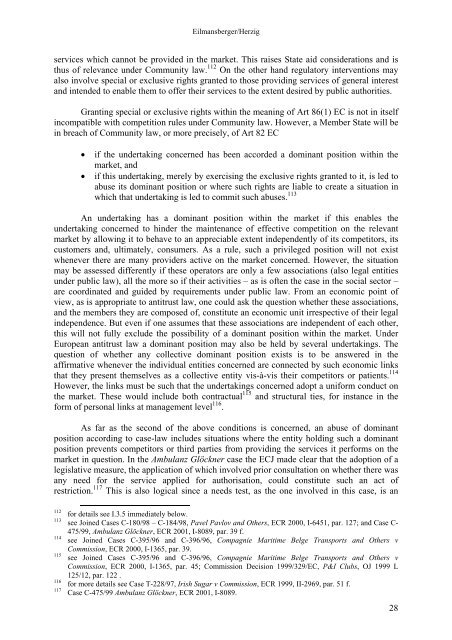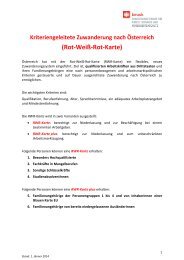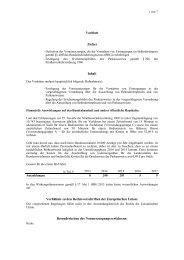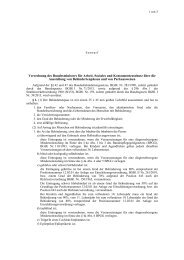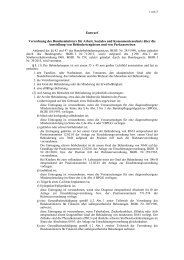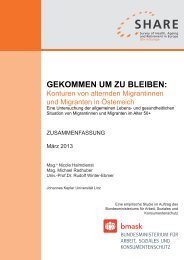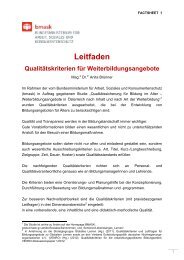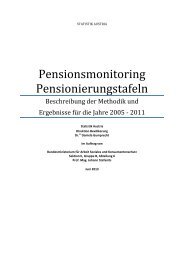Social Services of General Interest (SSGI)
Social Services of General Interest (SSGI)
Social Services of General Interest (SSGI)
Create successful ePaper yourself
Turn your PDF publications into a flip-book with our unique Google optimized e-Paper software.
Eilmansberger/Herzig<br />
services which cannot be provided in the market. This raises State aid considerations and is<br />
thus <strong>of</strong> relevance under Community law. 112 On the other hand regulatory interventions may<br />
also involve special or exclusive rights granted to those providing services <strong>of</strong> general interest<br />
and intended to enable them to <strong>of</strong>fer their services to the extent desired by public authorities.<br />
Granting special or exclusive rights within the meaning <strong>of</strong> Art 86(1) EC is not in itself<br />
incompatible with competition rules under Community law. However, a Member State will be<br />
in breach <strong>of</strong> Community law, or more precisely, <strong>of</strong> Art 82 EC<br />
• if the undertaking concerned has been accorded a dominant position within the<br />
market, and<br />
• if this undertaking, merely by exercising the exclusive rights granted to it, is led to<br />
abuse its dominant position or where such rights are liable to create a situation in<br />
which that undertaking is led to commit such abuses. 113<br />
An undertaking has a dominant position within the market if this enables the<br />
undertaking concerned to hinder the maintenance <strong>of</strong> effective competition on the relevant<br />
market by allowing it to behave to an appreciable extent independently <strong>of</strong> its competitors, its<br />
customers and, ultimately, consumers. As a rule, such a privileged position will not exist<br />
whenever there are many providers active on the market concerned. However, the situation<br />
may be assessed differently if these operators are only a few associations (also legal entities<br />
under public law), all the more so if their activities – as is <strong>of</strong>ten the case in the social sector –<br />
are coordinated and guided by requirements under public law. From an economic point <strong>of</strong><br />
view, as is appropriate to antitrust law, one could ask the question whether these associations,<br />
and the members they are composed <strong>of</strong>, constitute an economic unit irrespective <strong>of</strong> their legal<br />
independence. But even if one assumes that these associations are independent <strong>of</strong> each other,<br />
this will not fully exclude the possibility <strong>of</strong> a dominant position within the market. Under<br />
European antitrust law a dominant position may also be held by several undertakings. The<br />
question <strong>of</strong> whether any collective dominant position exists is to be answered in the<br />
affirmative whenever the individual entities concerned are connected by such economic links<br />
that they present themselves as a collective entity vis-à-vis their competitors or patients. 114<br />
However, the links must be such that the undertakings concerned adopt a uniform conduct on<br />
the market. These would include both contractual 115 and structural ties, for instance in the<br />
form <strong>of</strong> personal links at management level 116 .<br />
As far as the second <strong>of</strong> the above conditions is concerned, an abuse <strong>of</strong> dominant<br />
position according to case-law includes situations where the entity holding such a dominant<br />
position prevents competitors or third parties from providing the services it performs on the<br />
market in question. In the Ambulanz Glöckner case the ECJ made clear that the adoption <strong>of</strong> a<br />
legislative measure, the application <strong>of</strong> which involved prior consultation on whether there was<br />
any need for the service applied for authorisation, could constitute such an act <strong>of</strong><br />
restriction. 117 This is also logical since a needs test, as the one involved in this case, is an<br />
112<br />
for details see I.3.5 immediately below.<br />
113<br />
see Joined Cases C-180/98 – C-184/98, Pavel Pavlov and Others, ECR 2000, I-6451, par. 127; and Case C-<br />
475/99, Ambulanz Glöckner, ECR 2001, I-8089, par. 39 f.<br />
114<br />
see Joined Cases C-395/96 and C-396/96, Compagnie Maritime Belge Transports and Others v<br />
Commission, ECR 2000, I-1365, par. 39.<br />
115<br />
see Joined Cases C-395/96 and C-396/96, Compagnie Maritime Belge Transports and Others v<br />
Commission, ECR 2000, I-1365, par. 45; Commission Decision 1999/329/EC, P&I Clubs, OJ 1999 L<br />
125/12, par. 122 .<br />
116<br />
for more details see Case T-228/97, Irish Sugar v Commission, ECR 1999, II-2969, par. 51 f.<br />
117<br />
Case C-475/99 Ambulanz Glöckner, ECR 2001, I-8089.<br />
28


